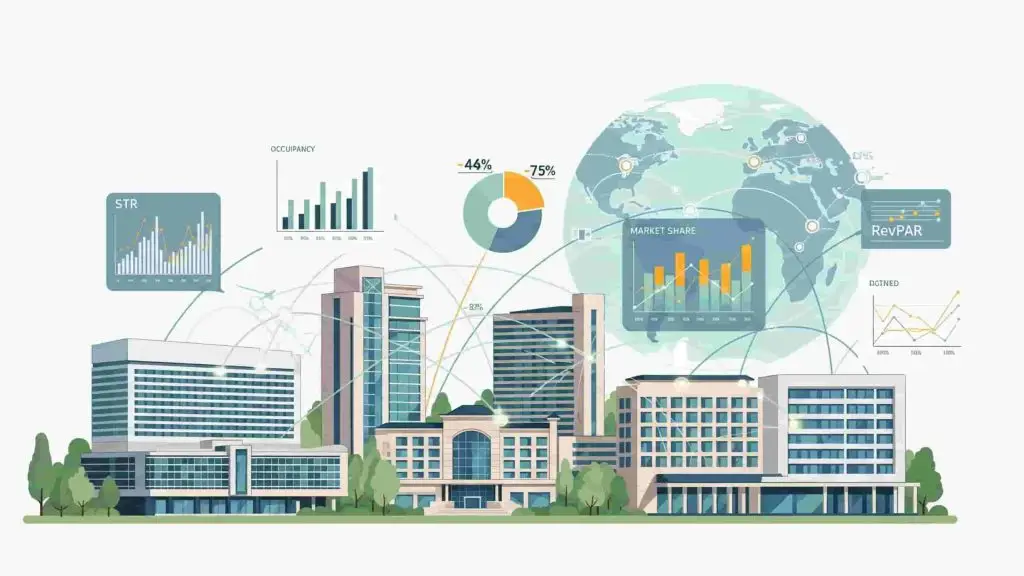
When you stay in a hotel, you might think the only thing that matters is how comfortable the bed is, how tasty the breakfast was, or whether the Wi-Fi worked properly. But behind the scenes, the hotel business is all about numbers.
This is where Smith Travel Research (STR) steps in. STR collects data from thousands of hotels worldwide and turns it into reports that show what’s really happening in the hospitality industry. For hotel owners, investors, and even governments, STR is like a compass—pointing the way in a competitive travel world.
In this article, we’ll take a long but easy walk through STR: what it is, how it works, why it matters, the types of reports it provides, career opportunities, and its role in shaping the future of travel.
What is Smith Travel Research (STR)?
Imagine a giant classroom full of students. Each hotel is like a student with their own grades. STR is the teacher who collects the marks, calculates the averages, and then tells each student:
- How they performed individually.
- How they did compared to classmates.
- How the whole class is doing overall.
Hotels share their data with STR, and in return, they get detailed insights on how they’re performing in their market. This helps them know whether they’re charging the right prices, attracting enough guests, or falling behind competitors.
The Story of STR
Back in 1985, Randy and Carolyn Smith in Hendersonville, Tennessee, noticed that hotels had no reliable way to measure performance. Hotels were mostly guessing when it came to pricing or planning. There was no system to compare one hotel’s success with another’s.
The Smiths decided to fix that. They started collecting real numbers directly from hotels—things like occupancy, rates, and revenue. It began as a family-run project but quickly grew as hotels realized how useful the data was.
Fast-forward to today: STR is no longer just a family business. Today, STR has grown worldwide, with teams working across North America, Europe, Asia, the Middle East, and Latin America.
STR Reports – The Hotel Scorecards

STR’s main product is its reports. These reports are like report cards for hotels, giving them detailed feedback on performance.
Here are the key types of STR reports:
1. STAR Report (Smith Travel Accommodations Report)
This is the most popular report. Think of it as a hotel’s own report card that shows how it’s really doing.
- Shows occupancy, ADR, and RevPAR.
- Compares a hotel to its competitive set (similar hotels in the same area).
- Helps managers know if they’re leading, keeping up, or falling behind.
2. Pipeline Report
Tracks hotels that are planned, approved, or under construction. This helps investors see:
- Which cities will soon have too many hotels (risk of oversupply).
- Which areas still have opportunities for growth.
3. Profitability Report
Goes deeper into the financial side. Instead of just revenue, it shows profit margins after expenses. Very useful for owners, analysts, and banks.
4. Host Report
A big-picture report, released annually. It shows average revenues, costs, and profits across the hotel industry.
5. Census Database
A huge list of hotels worldwide with important details—brand, size, rooms, and chain scale. Often used by developers and consultants.
STR’s Golden Metrics
STR reports focus on three main numbers—often called the golden metrics of hotels.
- How many rooms were filled out of total rooms available.
- The average price paid per room sold.
- Occupancy × ADR.
These three numbers are the foundation of every STR report and are used daily by hotels, investors, and analysts.
STR Chain Scale – Making Comparisons Fair

Not all hotels are the same. Comparing a Ritz-Carlton to a roadside motel isn’t fair. That’s why STR created the chain scale system—grouping hotels into categories based on their average rates.
This makes benchmarking meaningful and helps investors know which segments are performing best.
Why STR is So Important
STR isn’t just numbers—it’s the backbone of decision-making in hospitality.
Benefits for Hotels
- Set smarter prices.
- Track performance against competitors.
- Adjust marketing and operations based on real data.
Benefits for Investors
- See which markets are oversupplied or growing.
- Plan new hotel projects with less risk.
Benefits for Tourism Boards & Cities.
- Attract events, festivals, and tourists.
- Plan infrastructure like airports and convention centers.
During Crises
In tough times, STR becomes a survival guide. For example, during COVID-19, STR data showed which hotels were staying open, how occupancy was changing, and how recovery was happening city by city.
Careers at STR

Working at STR is not just about crunching numbers—it’s about shaping the hotel industry’s future.
Job Roles
Data Analysts → Turn raw numbers into insights.
Market Researchers → Predict travel and tourism trends.
Client Support & Account Managers → Work directly with hotels and investors.
Sales & Partnerships → Grow STR’s global network.
The Future of STR
The travel industry keeps changing—and STR is evolving with it.
- Real-time data → Faster insights instead of waiting weeks.
- AI forecasting → Using machine learning to predict demand.
- Beyond hotels → Covering vacation rentals and alternative lodging.
- Sustainability tracking → Helping hotels monitor eco-friendly travel trend
STR – From Guesswork to Guidance
Before STR, hotels were running blind—making guesses about prices, demand, and competition. Today, STR gives them clarity. It helps hotels know exactly where they stand, investors plan smarter, and cities grow with confidence.
What began with Randy and Carolyn Smith’s vision in Tennessee is now a worldwide network powering the decisions that shape global travel.
As the world of hospitality grows—through luxury resorts, budget hotels, vacation rentals, and sustainable tourism—STR will continue to be the compass that points the way forward.
STR in the Travel Industry
Think of STR (Smith Travel Research) as the Google of hotel numbers. Hotels share their data with STR—like how many rooms got booked, what price they sold at, and how much money they made. STR collects all this and then shows the bigger picture of what’s really happening in travel.
Role of Smith Travel Research in Tourism Development
Tourism doesn’t grow by luck—it grows with planning. STR helps in that planning.
If a city is filling up hotels every weekend, STR will show it.
If another city is empty, STR will highlight that too.
Investors use this info to decide where to build new hotels.
How STR Helps Governments and Tourism Boards
Imagine a government without data… it’s like driving with closed eyes. That’s why tourism boards rely on STR.
They check which areas are doing well and which need help.
They measure how big events (like IPL, concerts, or festivals) boost hotels.
They plan new airports, roads, or campaigns based on real numbers.
Basically, STR gives them the confidence to plan smart moves instead of just guessing.
Digital Ledger in Travel Industry vs STR Data
This is where people get confused, so let’s keep it super simple.
Smith Travel Research and the Power of Data Analytics
Data may sound boring, but STR makes it powerful.
They predict if domestic or foreign travelers will come more.
STR’s Use of Technology in Modern Hospitality
Hotels today don’t just look at their own sales—they look at the whole market. STR makes this possible.
STR cleans it, processes it, and turns it into easy-to-read charts.
Managers use this info to adjust pricing, marketing, or staffing.
Read More: Best Costco Travel Hotels in USA

Pingback: Travel Ledger Reports & Payment System for Travel Agencies -